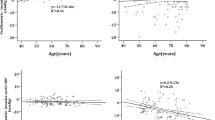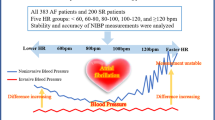Abstract
Although the accuracy of oscillometric blood pressure (BP) measurement is not so satisfied, the BP reading is still associated with cardiovascular events and death in patients with atrial fibrillation (AF). Because the currently used auscultatory or oscillometric methods were developed on sinus rhythm (SR), these BP measurement methods were not reasonable for AF patients. It is suggested that the average of three BP readings in the AF patients is accepted in clinical, even so, high systolic BP (SBP) variability and inaccurate diastolic BP (DBP) value have been reported in AF patients. In sinus rhythm, oscillometric pressure pulses (OPPs) are spindle-like, regardless of the heart rate. However, the shape of OPP is obviously associated with frequency of ventricular rate (VR) in AF patients. When the VR is rapid, the OPP is far from a spindle-like shape. With intro-aortic BP as reference, a study demonstrated that the oscillometric SBP level significantly underestimated the intro-aortic SBP level in the AF patients with increasing VR. In clinical practice, the physician should use the average of three BP readings in the AF patients. When the mean pulse rates (PR) reported by the oscillometric BP devise is less than 90 bpm and the variation of three pulse rate <10 bpm, the oscillometric SBP readings may be clinically accepted in AF patients. It is necessary to develop a new BP measurement method for AF as the current methods in AF are not so accurate as in SR.
This is a preview of subscription content, access via your institution
Access options
Subscribe to this journal
Receive 12 digital issues and online access to articles
$119.00 per year
only $9.92 per issue
Buy this article
- Purchase on Springer Link
- Instant access to full article PDF
Prices may be subject to local taxes which are calculated during checkout




Similar content being viewed by others
References
Rao MP, Halvorsen S, Wojdyla D, Thomas L, Alexander JH, Hylek EM. et al. Blood pressure control and risk of stroke or systemic embolism in patients with atrial fibrillation: results from the Apixaban for Reduction in Stroke and Other Thromboembolic Events in Atrial Fibrillation (ARISTOTLE) Trial. J Am Heart Assoc. 2015;4:pii: e002015. https://doi.org/10.1161/JAHA.115.002015.
Grundvold I, Skretteberg PT, Liestøl K, Erikssen G, Kjeldsen SE, Arnesen H, et al. Upper normal blood pressures predict incident atrial fibrillation in healthy middle-aged men: a 35-year follow-up study. Hypertension. 2012;59:198–204.
Lip GY, Frison L, Grind M, SPORTIF Investigators. Effect of hypertension on anticoagulated patients with atrial fibrillation. Eur Heart J. 2007;28:752–9.
Badheka AO, Patel NJ, Grover PM, Shah N, Patel N, Singh V, et al. Optimal blood pressure in patients with atrial fibrillation (from the AFFIRM Trial). Am J Cardiol. 2014;114:727–36.
Ochiai H, Mitake A, Miyata T, Ishigami T, Ashino K, Sumita S, et al. Assessment of auscultatory blood pressure measurements versus intro-arterial pressure in patients with atrial fibrillation. J Cardiol. 1997;29:331–6.
Kyriakoulis KG, Kollias A, Stergiou GS. Blood pressure and outcome in patients with atrial fibrillation: floating in uncharted waters. J Hypertension. 2021;39:592–3.
Posey JA, Geddes LA, Williams H, Moore AG. The meaning of the point of maximum oscillations in cuff pressure in the indirect measurement of blood pressure. 1. Cardiovasc Res Cent Bull. 1969;8:15–25.
Geddes LA, Voelz M, Combs C, Reiner D, Babbs CF. Characterization of the oscillometric method for measuring indirect blood pressure. Ann Biomed Eng. 1982;10:271–80.
Alpert BS, Quinn D, Gallick D. Oscillometric blood pressure: a review for clinicians. J Am Soc Hypertens. 2014;8:930–8.
Stewart MJ, Gough K, Padfield PL. The accuracy of automated blood pressure measuring devices in patients with controlled atrial fibrillation. J Hypertens. 1995;13:297–300.
Stergiou GS, Kollias A, Destounis A, Tzamouranis D. Automated blood pressure measurement in atrial fibrillation: a systematic review and meta-analysis. J Hypertens. 2012;30:2074–82.
Stergiou GS, Kyriakoulis KG, Stambolliu E, Destounis A, Karpettas N, Kalogeropoulos P, et al. Blood pressure measurement in atrial fibrillation: review and meta-analysis of evidence on accuracy and clinical relevance. J Hypertens. 2019;37:2430–41.
Clark CE, McDonagh STJ, McManus RJ. Accuracy of automated blood pressure measurements in the presence of atrial fibrillation: systematic review and meta-analysis. J Hum Hypertens. 2019;33:352–64.
Park SH, Choi YK. Measurement reliability of automated oscillometric blood pressure monitor in the elderly with atrial fibrillation: a systematic review and meta-analysis. Blood Press Monit. 2020;25:2–12.
Cheng HM, Tufanaru C, Pearson A, Chen CH. Automated blood pressure measurement in atrial fibrillation: a systematic review and meta-analysis. J Hypertension. 2013;31:214–5. (Opposite opinion).
Stergiou GS, Kollias A, Destounis A, Tzamouranis D. Automated blood pressure measurement in atrial fibrillation: a systematic review and meta-analysis. J Hypertension. 2013;31:215–6.
Šelmytė-Besusparė A, Barysienė J, Petrikonytė D, Aidietis A, Marinskis G, Laucevičius A. Auscultatory versus oscillometric blood pressure measurement in patients with atrial fibrillation and arterial hypertension. BMC Cardiovasc Disord. 2017;17:87. https://doi.org/10.1186/s12872-017-0521-6
Maselli M, Giantin V, Corrado D, Franchin A, Attanasio F, Pengo V, et al. Reliability of oscillometric blood pressure monitoring in atrial fibrillation patients admitted for electric cardioversion. J Clin Hypertens (Greenwich). 2015;17:558–64.
Vázquez-Rodríguez B, Pita-Fernández S, Regueiro-López M, García-Pedreira D, Carro-Rodriguez MJ, Pérez-Rivas G, et al. Concordance between automatic and manual recording of blood pressure depending on the absence or presence of atrial fibrillation. Am J Hypertens. 2010;23:1089–94.
Caramella JP, Desmonts JM. Reliability of automatic oscillometric monitoring of arterial pressure. Effect of hypotension and arrhythmias. Arch Mal Coeur Vaiss. 1986;79:1794–9.
Pagonas N, Schmidt S, Eysel J, Compton F, Hoffmann C, Seibert F, et al. Impact of atrial fibrillation on the accuracy of oscillometric blood pressure monitoring. Hypertension. 2013;62:579–84.
Halfon M, Wuerzner G, Marques-Vidal P, Taffe P, Vaucher J, Waeber B, et al. Use of oscillometric devices in atrial fibrillation: a comparison of three devices and invasive blood pressure measurement. Blood Press. 2018;27:48–55.
Pagonas N, Schmidt S, Eysel J. Impact of atrial fibrillation on the accuracy of oscillometric blood pressure monitoring. Hypertension. 2013;62:579–84.
Giantin V, Perissinotto E, Franchin A, Baccaglini K, Attanasio F, Maselli M, et al. Ambulatory blood pressure monitoring in elderly patients with chronic atrial fibrillation: is it absolutely contraindicated or a useful tool in clinical practice and research? Hypertens Res. 2013;36:889–94.
Babbs CF. Oscillometric measurement of systolic and diastolic blood pressures validated in a physiologic mathematical model. Biomed Eng Online. 2012;22:56.
Vos J, Vincent HH, Verhaar MC, Bos WJ. Inaccuracy in determining mean arterial pressure with oscillometric blood pressure techniques. Am J Hypertens. 2013;26:624–9.
Xie F, Xu J, Xia LL, Luo X, Jiang Z, Wu Y, et al. The impact of atrial fibrillation on accuracy of oscillometric blood pressure measurement: effect of ventricular rate. Hypertens Res. 2020;43:518–24.
Feenstra RK, Allaart CP, Berkelmans GFN, Westerhof BE, Smulders YM. Accuracy of oscillometric blood pressure measurement in atrial fibrillation. Blood Press Monit. 2018;23:59–63.
Wang XX, Shuai W, Hong K, Xu J, Li JX, Li P, et al. How to evaluate BP measurements using the oscillometric method in atrial fibrillation: the value of pulse rate variation. Hypertens Res. 2016;39:588–92.
Huppertz N, Lip GYH, Lane DA. Validation of the modified Microlife blood pressure monitor in patients with paroxysmal atrial fibrillation. Clin Res Cardiol. 2020;109:802–9.
Muntner P, Shimbo D, Carey RM, Charleston JB, Gaillard T, Misra S, et al. Measurement of blood pressure in humans: a scientific statement from the american heart association. Hypertension. 2019;73:e35–e66.
Parati G, Omboni S, Palatini P, Rizzoni D, Bilo G, Valentini M, et al. Italian society of hypertension guidelines for conventional and automated blood pressure measurement in the office, at home and over 24h. High Blood Press Cardiovasc Prev. 2008;15:283–310.
Tong HY, Fan WG, Su H. The usefulness of 24-hour blood pressure monitoring for the patients with atrial fibrillation: based on the variability of blood pressure parameters. Blood Press Monit. 2020;25:22–25.
Kollias A, Stergiou GS. Automated measurement of office, home and ambulatory blood pressure in atrial fibrillation. Clin Exp Pharmacol Physiol. 2014;41:9–15.
Author information
Authors and Affiliations
Contributions
HS prepared the manuscript and ZG reviewed the paper.
Corresponding author
Ethics declarations
Competing interests
The authors declare no competing interests.
Additional information
Publisher’s note Springer Nature remains neutral with regard to jurisdictional claims in published maps and institutional affiliations.
Rights and permissions
About this article
Cite this article
Su, H., Guo, Z. Accuracy of non-invasive blood pressure measurement in patients with atrial fibrillation. J Hum Hypertens 36, 229–234 (2022). https://doi.org/10.1038/s41371-021-00596-3
Received:
Revised:
Accepted:
Published:
Issue Date:
DOI: https://doi.org/10.1038/s41371-021-00596-3
This article is cited by
-
Accuracy of oscillometric-based blood pressure monitoring devices: impact of pulse volume, arrhythmia, and respiratory artifact
Journal of Human Hypertension (2023)



